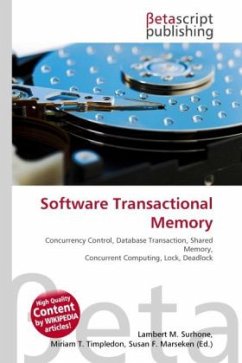
Software Transactional Memory
Versandkostenfrei!
Versandfertig in 6-10 Tagen
19,99 €
inkl. MwSt.

PAYBACK Punkte
10 °P sammeln!
High Quality Content by WIKIPEDIA articles! In computer science, software transactional memory (STM) is a concurrency control mechanism analogous to database transactions for controlling access to shared memory in concurrent computing. It functions as an alternative to lock-based synchronization. A transaction in this context is a piece of code that executes a series of reads and writes to shared memory. These reads and writes logically occur at a single instant in time; intermediate states are not visible to other (successful) transactions. The idea of providing hardware support for transacti...
High Quality Content by WIKIPEDIA articles! In computer science, software transactional memory (STM) is a concurrency control mechanism analogous to database transactions for controlling access to shared memory in concurrent computing. It functions as an alternative to lock-based synchronization. A transaction in this context is a piece of code that executes a series of reads and writes to shared memory. These reads and writes logically occur at a single instant in time; intermediate states are not visible to other (successful) transactions. The idea of providing hardware support for transactions originated in a 1986 paper and patent by Tom Knight. The idea was popularized by Maurice Herlihy and J. Eliot B. Moss. In 1995 Nir Shavit and Dan Touitou extended this idea to software-only transactional memory (STM). STM has recently been the focus of intense research and support for practical implementations is growing.












